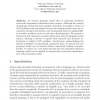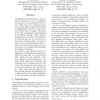45 search results - page 1 / 9 » A Semantics-Enhanced Language Model for Unsupervised Word Se... |
CICLING
2008
Springer
13 years 6 months ago
2008
Springer
An N-gram language model aims at capturing statistical word order dependency information from corpora. Although the concept of language models has been applied extensively to handl...
ACL
2004
13 years 6 months ago
2004
We describe two probabilistic models for unsupervised word-sense disambiguation using parallel corpora. The first model, which we call the Sense model, builds on the work of Diab ...
CICLING
2003
Springer
13 years 9 months ago
2003
Springer
This paper presents a graph-theoretical approach to lexical disambiguation on word co-occurrences. Producing a dictionary similar to WordNet, this method is the counterpart to word...
ACL
2006
13 years 6 months ago
2006
This paper presents a new approach based on Equivalent Pseudowords (EPs) to tackle Word Sense Disambiguation (WSD) in Chinese language. EPs are particular artificial ambiguous wor...
ACL
2006
13 years 6 months ago
2006
Morphological disambiguation is the process of assigning one set of morphological features to each individual word in a text. When the word is ambiguous (there are several possibl...


